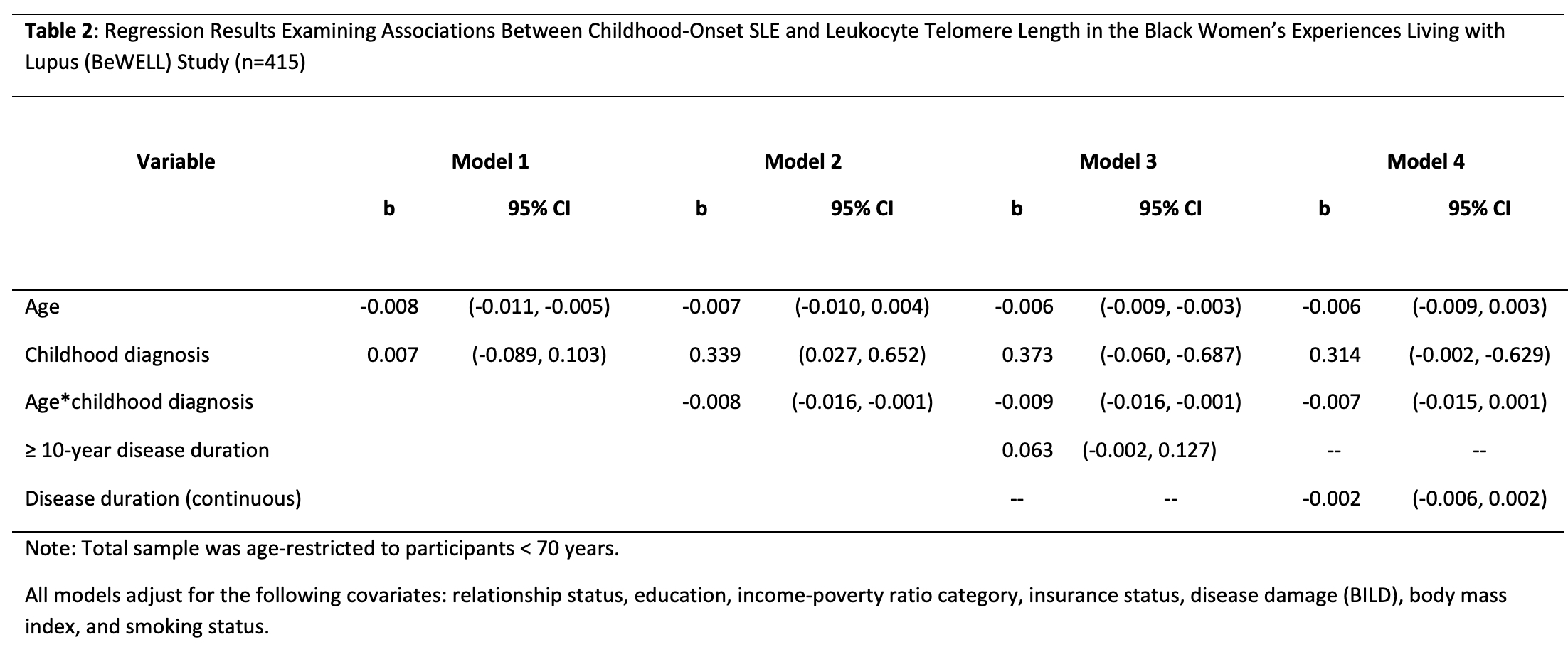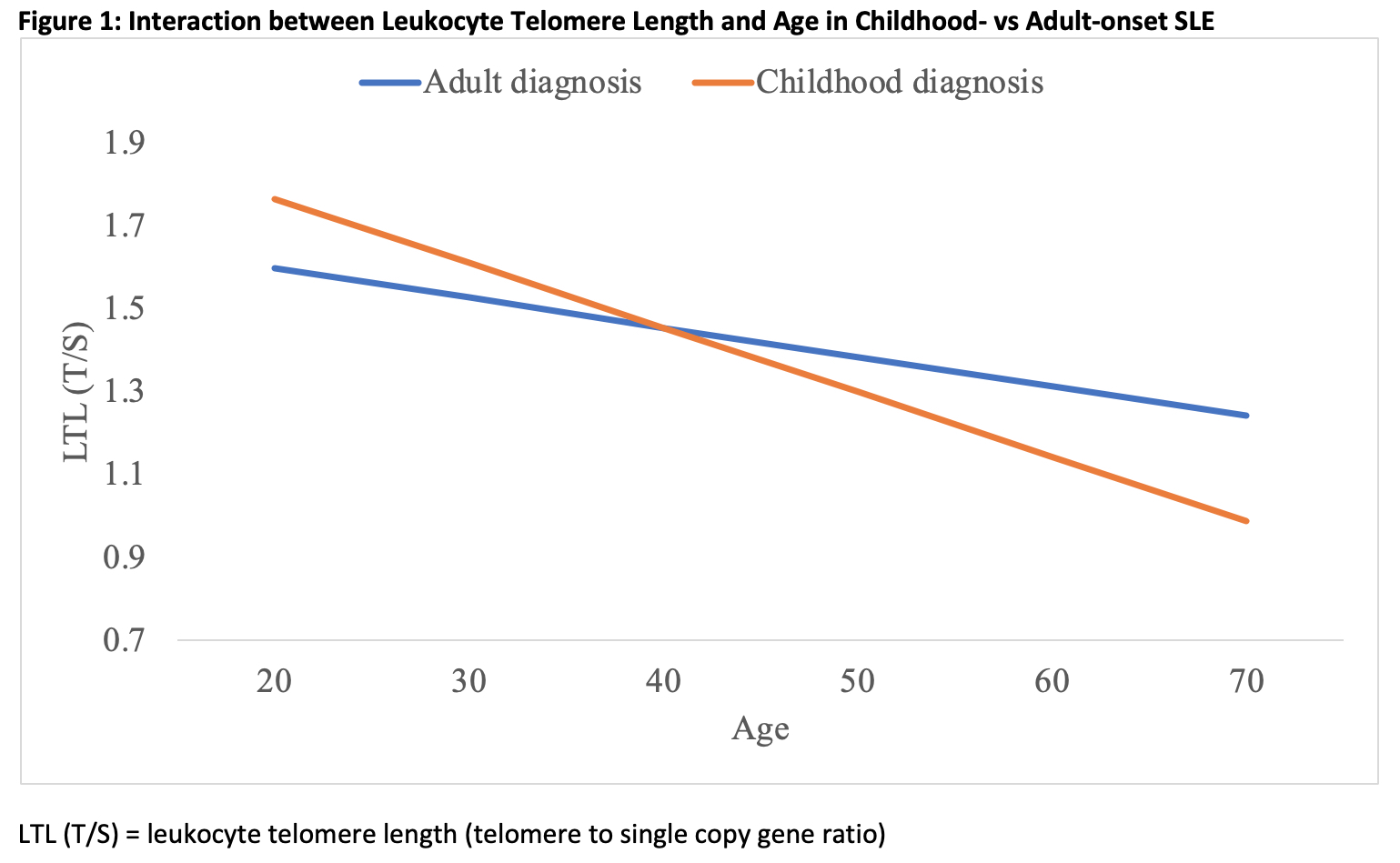Session Information
Date: Sunday, November 8, 2020
Title: SLE – Diagnosis, Manifestations, & Outcomes II: Bench to Bedside (1507–1511)
Session Type: Abstract Session
Session Time: 3:00PM-3:50PM
Background/Purpose: Childhood-onset SLE is generally more aggressive than adult-onset SLE. Leukocyte telomere length (LTL) has been posited to reflect immune system aging. Short LTL in particular has been associated with chronic health conditions mediated by inflammatory pathways as well as all-cause mortality. Prior studies have found evidence for shorter LTL among patients with SLE compared to healthy controls. However, no studies to date have compared LTL among SLE patients diagnosed in childhood vs. adulthood.
Methods: Data are from the Black Women’s Experiences Living with Lupus (BeWELL) Study. A total of 438 Black women living in the Atlanta, Georgia metropolitan area with a validated diagnosis of SLE (≥ 4 American College of Rheumatology SLE criteria or 3 criteria with a diagnosis of SLE by a board-certified rheumatologist) were recruited between April 2015-May 2017. Multivariable linear regression analyses were conducted examining childhood diagnosis of SLE (< 18 years of age derived from self-reported age and disease duration) in relation to LTL assayed from dried blood spots, measured as the relative telomere to single copy gene (T/S) ratio.
Results: Seven participants without a valid measure of LTL were excluded from analyses. Among those diagnosed in childhood, the oldest participant was 69 years of age. Analyses were restricted to those < 70 years of age resulting in a total analytic sample size of 415. A total of 40 participants (9.6%) were diagnosed in childhood. Multivariable linear regression analyses were conducted adjusting for a range of demographic, socioeconomic and health-related covariates, including smoking status, body mass index, and disease damage measured using the Brief Index of Lupus Damage (Table 2). Results indicated no main effect of childhood diagnosis on LTL (Model 1: b=0.007, 95% CI: -0.089, 0.103). However, the interaction between age and childhood diagnosis was significant (Model 2: b—0.008, -0.016, -0.001), indicating a steeper inverse association between age and LTL among those diagnosed in childhood compared to those diagnosed in adulthood (Figure 2). This interaction continued to be significant at p=0.024 (Model 3) after controlling for disease duration measured dichotomously (< 10 years vs. >= 10 years); and was marginally significant at p=0.083 (Model 4) when examined continuously.
Conclusion: This cross-sectional analysis suggests that Black women with childhood-onset SLE may undergo accelerated LTL shortening compared to their adult-onset counterparts. We found that this relationship persisted even after controlling for differences in SLE damage and disease duration. Future longitudinal research modeling within-person change in LTL over time that includes larger samples of those diagnosed in childhood may help to uncover if this finding is an artifact of cohort effects, or if there are other mechanisms involved in more rapid LTL shortening in this population. Despite limitations, these findings inform research on immunosenescence mechanisms of SLE.
To cite this abstract in AMA style:
Bridges J, Chung K, Martz C, Smitherman E, Drenkard C, Lim S, Chae D. Leukocyte Telomere Length and Childhood Onset of Systemic Lupus Erythematosus in the Black Women’s Experiences Living with Lupus (BeWELL) Study [abstract]. Arthritis Rheumatol. 2020; 72 (suppl 10). https://acrabstracts.org/abstract/leukocyte-telomere-length-and-childhood-onset-of-systemic-lupus-erythematosus-in-the-black-womens-experiences-living-with-lupus-bewell-study/. Accessed .« Back to ACR Convergence 2020
ACR Meeting Abstracts - https://acrabstracts.org/abstract/leukocyte-telomere-length-and-childhood-onset-of-systemic-lupus-erythematosus-in-the-black-womens-experiences-living-with-lupus-bewell-study/



